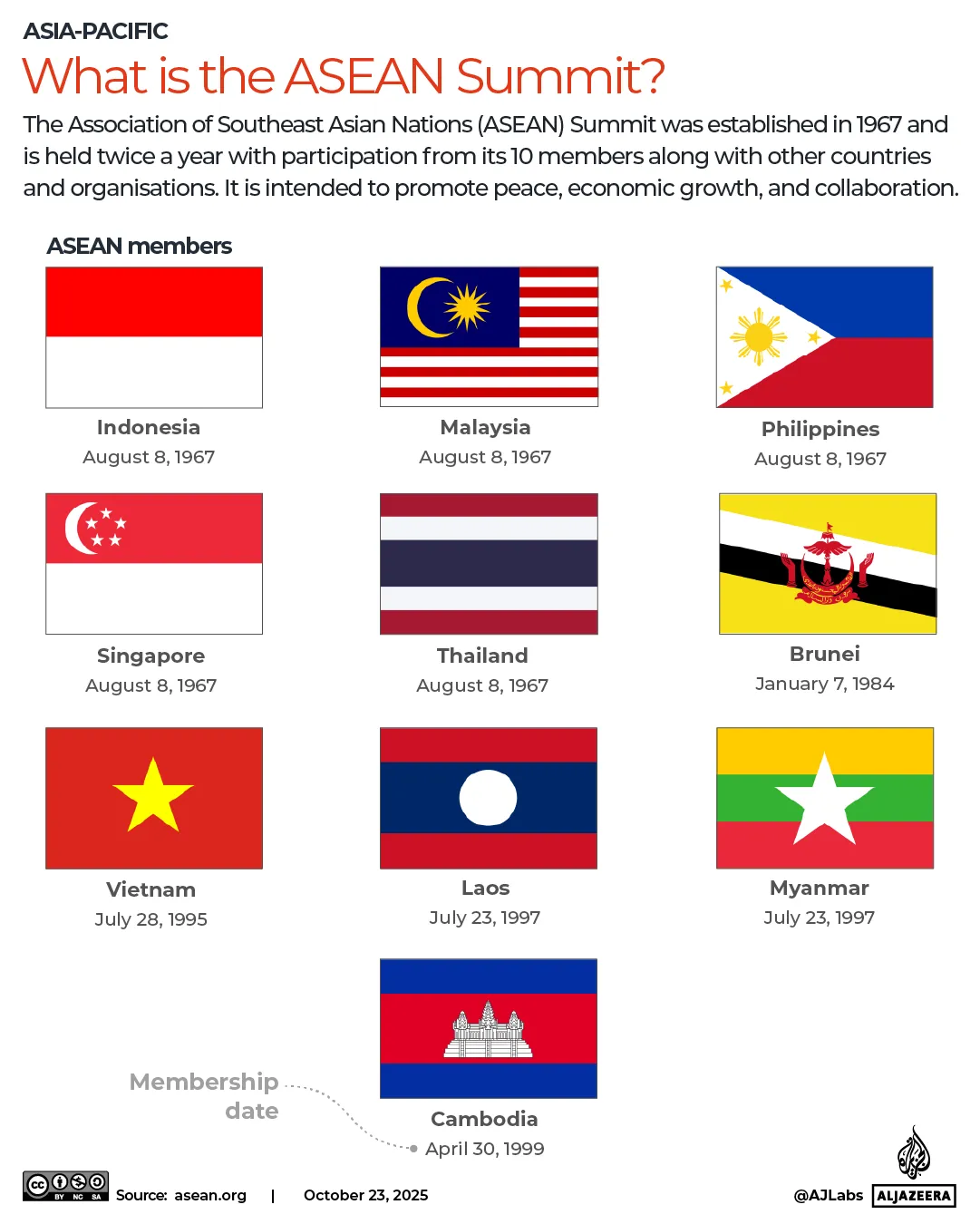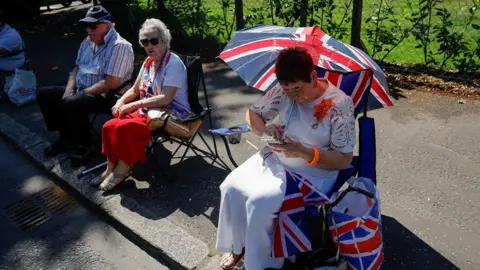ASEAN summit in Malaysia: Who’s attending and what to expect | ASEAN News
Nearly two dozen world leaders are descending in the Malaysian capital of Kuala Lumpur for a three-day summit of the Association of Southeast Asian Nations (ASEAN) from Sunday to Tuesday, and multiple other meetings on the sidelines.
This will be the 47th summit of the ASEAN.
Recommended Stories
list of 4 itemsend of list
Here’s what you need to know:
What is ASEAN, and who’s attending the summit?
ASEAN is made up of 10 members – Brunei, Cambodia, Indonesia, Laos, Malaysia, Myanmar, the Philippines, Singapore, Thailand and Vietnam. Together, they have a population of 678 million people and a gross domestic product of $3.9 trillion, according to the Office of the United States Trade Representative.

This year, ASEAN will induct its 11th member, East Timor. The country gained independence from Indonesia in 2002 and is home to 1.4 million people.
The summit will bring together leaders from every country in the bloc except for Myanmar’s acting president, Senior General Min Aung Hlaing.
The ASEAN summit is accompanied annually by the East Asia Summit, a gathering of leaders of the ASEAN nations, the US, China, India, Russia, Japan, South Korea, Australia and New Zealand.
This year, US President Donald Trump, Chinese Premier Li Qiang, Australian Prime Minister Anthony Albanese, newly appointed Japanese Prime Minister Sanae Takaichi, South Korean President Lee Jae Myung and New Zealand Prime Minister Christopher Luxon will be attending.
Russian Deputy Prime Minister Alexander Novak will represent Moscow while Indian Prime Minister Narendra Modi will take part virtually.
Beyond the leaders of ASEAN and the East Asia Summit nations, Brazilian President Luiz Inacio Lula da Silva, Canadian Prime Minister Mark Carney and South African President Cyril Ramaphosa will be in Kuala Lumpur too.
The heads of the World Bank, the International Monetary Fund, the International Labour Organization and the International Federation of Association Football, better known as FIFA, will also attend some sessions, according to Bernama, Malaysia’s state news agency.
What events will take place during the summit?
Apart from the ASEAN summit and the East Asia Summit, ASEAN will also hold separate conclaves with leaders of key powers in Kuala Lumpur.
There’s also a peace deal to be signed on Sunday when Cambodia and Thailand ink a pact to end a deadly border dispute. The ceremony will be presided over by Trump and Malaysian Prime Minister Anwar Ibrahim, according to Bernama.
The long-running border conflict rekindled in July when dozens of people were killed and hundreds of thousands displaced along the border. A ceasefire was reached after five days with the help of Malaysia, China and the US.
Despite the high-profile nature of the event, some critics have questioned whether the deal will be more of a photo-op for Trump than a lasting resolution. Ceasefire violations have continued since July while the original issue around border demarcation has also not been resolved, according to Mu Sochua, a former Cambodian opposition leader and president of the Khmer Movement for Democracy.
She told Al Jazeera the threat of tariffs from Trump helped bring Thailand and Cambodia to the negotiating table in a move that was effective in the short term but also controversial. “Critics in both countries say it amounted to economic blackmail – trading peace for trade benefits rather than addressing justice, sovereignty or local needs,” she said.
What will be discussed at the summit?
The ASEAN summit will discuss pressing issues like US tariffs and access to rare earth minerals, which are essential to high-tech manufacturing and whose production is dominated by China.
Trump launched his “Liberation Day Tariffs” in April against most US trading partners in a bid to lower the US trade deficit. After much negotiation, US tariffs for most ASEAN countries range from 10 to 20 percent while Brunei’s tariff rate is 25 percent. Tariffs for Laos and Myanmar are both 40 percent.
In response to Trump’s tariffs, China has tightened export restrictions on rare earths, a move that has been felt around the world.
Marco Foster, ASEAN director at the professional services firm Dezan Shira & Associates, told Al Jazeera that most attendees will be vying for a chance to speak to Trump about tariffs. “Pretty much everyone is going to be going after him or trying to get in the room with him or his people to talk about their deal,” he said. “Everyone will want to have a sideline meeting with Trump.”
Attendees are also expected to discuss pressing issues like Myanmar’s civil war and the proliferation of scam centres in Southeast Asia, which have earned criminal networks tens of billions of dollars.
Why is Myanmar skipping the summit?
Myanmar’s acting president will not attend the ASEAN summit, and Myanmar will not take the helm from Malaysia as next year’s ASEAN chair because it has been embroiled in a civil war since 2021. Instead, the role will fall to the Philippines.
In 2021, ASEAN issued a Five-Point Consensus, calling for an immediate ceasefire in Myanmar and humanitarian assistance while creating a special ASEAN envoy to help mediate the conflict. Four years later, critics said it has had little impact on the crisis.
Charles Santiago, co-chairman of ASEAN Parliamentarians for Human Rights, told Al Jazeera that he expected Myanmar and the fallout from the civil war to be discussed at the summit.
“Myanmar has become a destabilising factor, both [in terms of] security and social cohesion in the other parts of Southeast Asia,” he said. The civil war has facilitated the spread of the flow of drugs and weapons while creating a refugee crisis, he added.
Still, Santiago said he did not expect much to come from the ASEAN summit. “This will be a major photo opportunity for everybody,” he said, but “nothing much will happen” in terms of policy.
What are ASEAN’s limitations?
ASEAN has sometimes been criticised for lacking an enforcement mechanism to force members to abide by its rulings. This makes it different from other regional blocs like the European Union, whose members must abide by EU laws and rulings.
It’s a criticism that has been heard recently around issues like Myanmar as well as the Cambodian-Thai border conflict.
Foster said this feature is a legacy of ASEAN’s unique history. The organisation was founded in 1967 after a major wave of decolonisation around the world. Its structure reflects the norms of the era, he said.
“Because of the narrative that ASEAN was born out of independence, it will never lead to an ASEAN that will limit [member states’] independence by accepting rules from a body that is above the state,” Foster said. “The nation state will always be the number one in ASEAN.”













